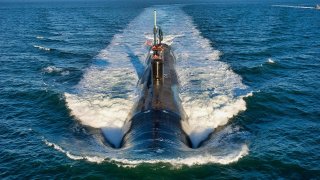Block V Virginia-Class: The Submarine the U.S. Navy Desperately Needs
Block V Virginia-class submarines are being built in Groton, Connecticut. Many more Block V’s have been ordered and will be built shortly. Block V offers a number of upgrades from the first four Virginia-class blocks, and it could serve for another five decades.
Block V Virginia-class submarines are being built in Groton, Connecticut. Many more Block V’s have been ordered and will be built shortly. Block V offers a number of upgrades from the first four Virginia-class blocks, and it could serve for another five decades.
Meet the Virginia-Class Block V
The Virginia was designed as a class of fast-attack submarines meant to be more affordable than the $2.8 billion Seawolf class. While the Seawolf was a capable fast-attack sub, it was so expensive that the program was cancelled after only three subs were built.
The Virginia class is cheap by comparison, costing $1.8 billion per unit. Both submarine classes were built to replace the aging Los Angeles class.
To date, quite a few Virginia-class submarines have entered service, most of them from Blocks I, II, and III. Only a few Block IV Virginias are in service. Given that the Block IV program is not yet complete, and is a highly capable submarine, the Block V is especially forward-looking.
It was designed to address a specific vulnerability: the growing missile gap between the U.S. and rising superpower China.
China's Missiles Have the Right Range
China is building up its military at scale despite enjoying 40 years of relative peace.
Beijing is especially busy building up China’s navy and air force, as well as its nuclear and conventional arsenals. In the meantime, China is making aggressive territorial claims in the Pacific region. Over the last two decades, while China committed time and resources to augmenting its military, the U.S. was bogged down with tangential wars in the Middle East.
The perpetual conflicts in Afghanistan, Iraq, and throughout the region, drained American resources and attention.
Meanwhile, China converted latent power into actual power, pulling even and surpassing the U.S. in certain regards.
For example, China now possesses the largest navy in the world. But perhaps more important, China built an impressive stockpile of cruise and ballistic missiles. The U.S. fell behind, and a missile gap took shape.
Part of the problem for the U.S. is that China has more missiles. The more significant problem, however, is that those missiles also have greater range. China is approaching monopoly status on intermediate-range missiles in the region. Obviously, the U.S. has the capacity to build intermediate-range missiles. But it was long a signatory to the Intermediate-Range Nuclear Forces Treaty – a Cold War pact between the U.S. and the Soviet Union that forbids it from deploying missiles with an effective range between 500 and 5,500 kilometers.
China never signed the Treaty, and remains free to deploy intermediate-range missiles as it pleases. It has done so in massive numbers. Recognizing the widening missile gap, the Trump administration withdrew from the INF, and now the U.S. is working to close the missile gap.
Block V Virginia-Class Submarine: Picking Up the Slack
China’s missiles were designed to face down American aircraft carriers, surface warships, and bases – essentially, the backbone of U.S. power in Asia. The missile gap will widen further once the U.S. retires its Ohio-class submarines. This is why the U.S. is urgently working to develop the Block V Virginia-class submarine, which will help pick up the slack that the Ohio’s retirement creates.
With the missile gap in mind, the latest Virginia Block was designed with a groundbreaking new concept, the Virginia Payload Module, or VPM. The VPM is a hull plug that will allow the vessels to carry three times as many Tomahawk missiles as the Block IV.
Assuming the Block is built and deployed punctually, it will be just one step toward closing the missile gap.
About the Author
Harrison Kass is a senior editor with over 1,000 published articles. An attorney, pilot, guitarist, and minor pro hockey player, he joined the US Air Force as a Pilot Trainee but was medically discharged. Harrison holds a BA from Lake Forest College, a JD from the University of Oregon, and an MA from New York University. He lives in Oregon and listens to Dokken. Email the Author: [email protected].


